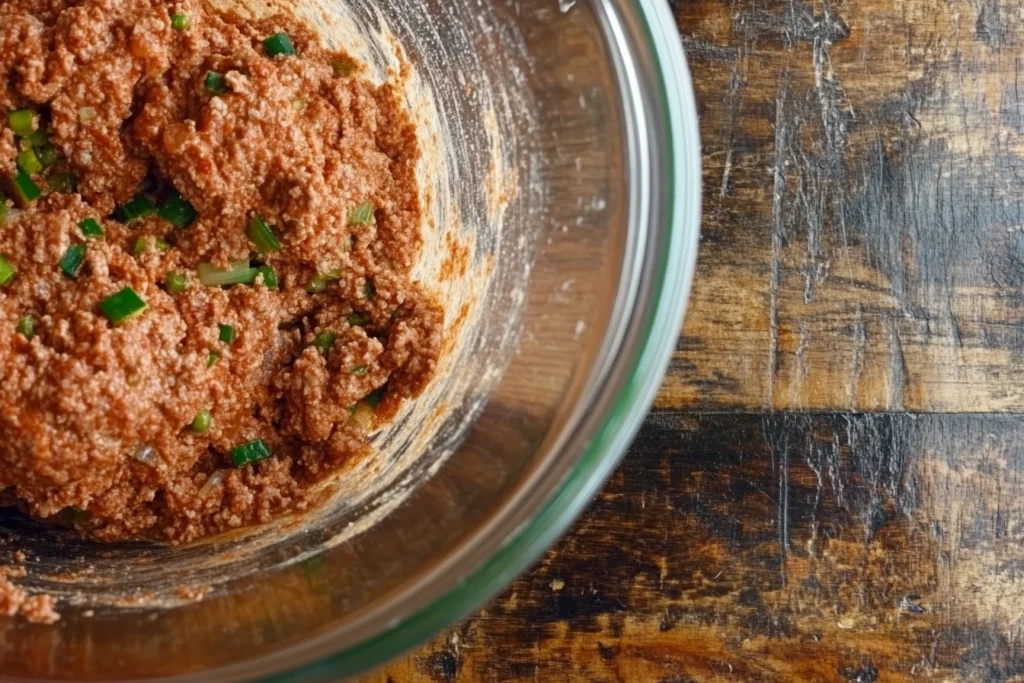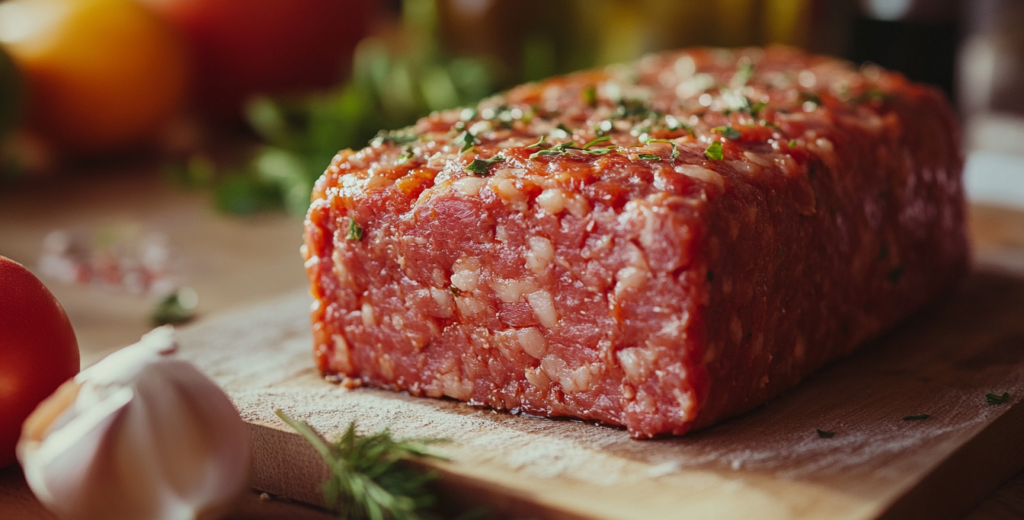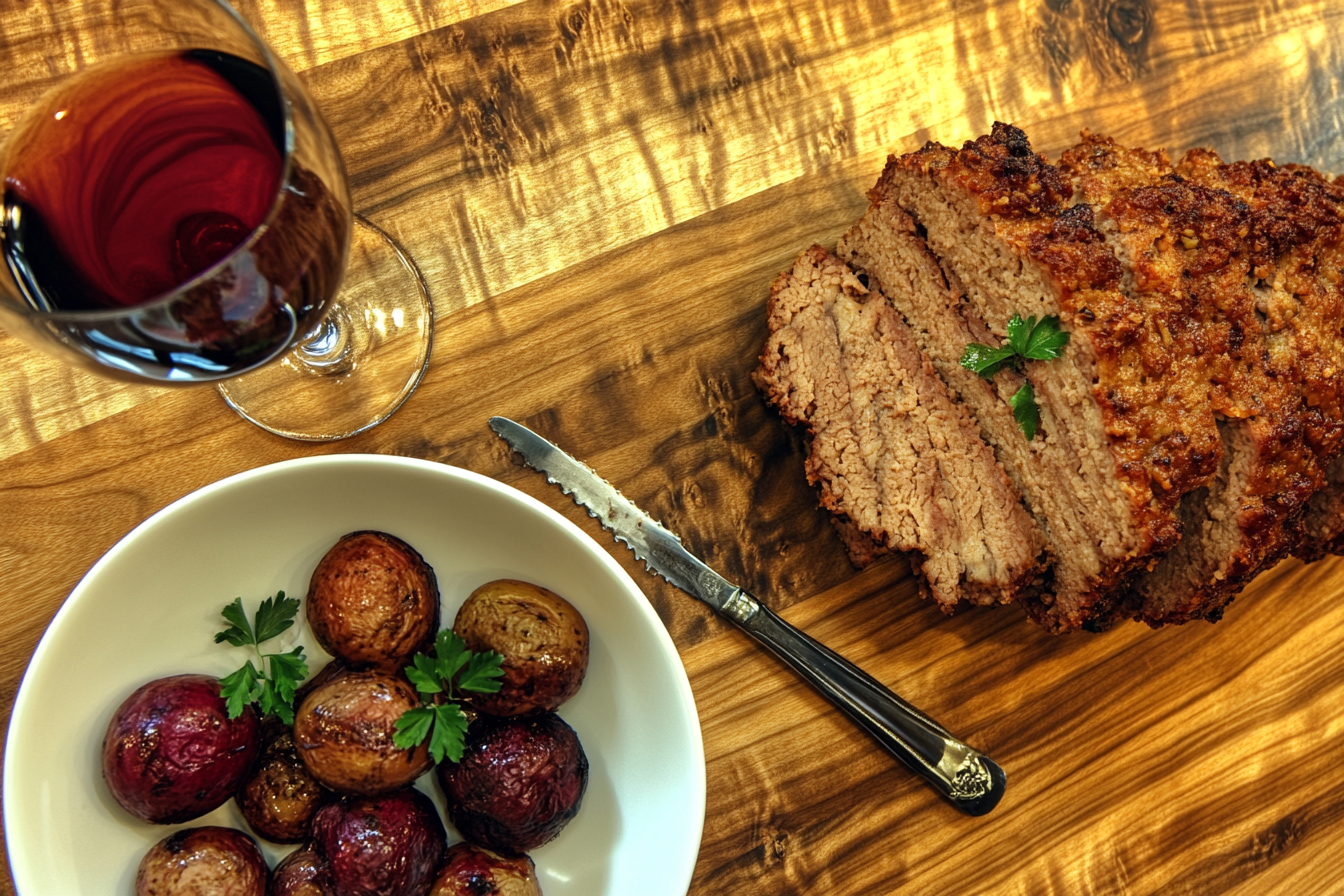Part 1: Understanding the Basics of Meatloaf
What is Meatloaf?
Basic Meatloaf:Meatloaf is a beloved dish with a rich history. Its origins trace back to ancient times, with roots in Roman cuisine, where minced meat was mixed with spices and breadcrumbs to create a filling and economical meal. Over time, meatloaf evolved, becoming a staple in American households, especially during the Great Depression, thanks to its affordability and versatility.
Globally, meatloaf takes on unique forms:
- Germany: “Hackbraten,” often served with boiled potatoes and gravy.
- Italy: “Polpettone,” a rolled meatloaf stuffed with vegetables or cheese.
- The Philippines: “Embutido,” a sweet-savory variation wrapped in foil and steamed.
Despite regional differences, the essence of meatloaf remains consistent—comforting, hearty, and highly customizable.
Core Ingredients in a Meatloaf
To craft the perfect meatloaf, understanding its core ingredients is essential:
- Proteins: The base is usually ground beef, chicken, or a mix of the two. Other options include turkey, chicken, or plant-based alternatives for vegetarians.
- Binding Agents: Ingredients like eggs and breadcrumbs hold the loaf together, preventing it from falling apart during cooking. Variations include crushed crackers or cooked rice.
The ratio of these ingredients determines the meatloaf’s texture and flavor.
The Role of Moisture in Meatloaf
Moisture is the unsung hero in meatloaf recipes. Without it, the dish becomes dry and crumbly:
- Liquids like milk, broth, or water help to soften breadcrumbs, creating a tender texture.
- Balancing fat content in the meat (e.g., an 80/20 beef-to-fat ratio) ensures both flavor and juiciness.
Using too much liquid or lean meat can lead to a soggy or dense loaf, so precision matters.
Flavor Enhancers
Seasoning is where meatloaf transforms from basic to spectacular:
- Spices like garlic powder, onion powder, paprika, and black pepper are classics.
- Fresh herbs, such as parsley or thyme, offer a burst of flavor, while dried herbs provide convenience and longevity.
For a signature taste, try combining fresh and dried seasonings. A pinch of nutmeg or Worcestershire sauce can add unexpected depth.
The Secret to Perfect Texture
Achieving the ideal meatloaf texture lies in balancing the meat-to-filler ratio. A good rule of thumb is:
- 1 part filler (breadcrumbs, oats, etc.) to 4 parts meat.
Overmixing is a common pitfall. It activates proteins in the meat, leading to a dense and rubbery loaf. For best results:
- Gently mix the ingredients until just combined.
- Avoid pressing the mixture too tightly when shaping.
Popular Topping Options
No meatloaf is complete without a flavorful topping. Classic options include:
- Ketchup Glaze: A tangy-sweet blend of ketchup, brown sugar, and mustard.
- BBQ Sauce: Adds a smoky depth.
- Creative Alternatives: Experiment with salsa, teriyaki glaze, or cranberry sauce for a twist.
Apply toppings during the last 15 minutes of baking to create a caramelized finish.
Understanding Meatloaf Binding Agents
Binding agents are crucial to keeping the loaf intact. Traditional options include:
- Breadcrumbs or crushed crackers for structure.
- Gluten-free choices: Almond flour, quinoa flakes, or ground flaxseed work well for those with dietary restrictions.
Experiment with ratios to suit your taste and texture preferences.
Adding Vegetables for Nutrition
Vegetables can boost both the flavor and nutritional value of meatloaf. Popular choices:
- Chopped onions and carrots: Add sweetness and moisture.
- Hidden Veggies: Pureeing zucchini or spinach can sneak in nutrients for picky eaters.
Sautéing vegetables beforehand enhances their flavors and ensures they blend seamlessly into the loaf.
Choosing the Right Pan
The shape and size of your meatloaf affect its cooking:
- Loaf Pans: Create a uniform shape but can trap grease.
- Freeform Shapes: Allow for even cooking and crisp edges but may require more careful shaping.
For a healthier option, use a rack to drain excess fat while baking.
Meatloaf Variations
The versatility of meatloaf invites endless experimentation:
- Classic Beef Meatloaf: A hearty, traditional recipe.
- Low-Carb Options: Substitute breadcrumbs with almond flour or crushed chicken rinds.
Each variation brings a unique spin while adhering to the basic meatloaf formula.
Part 2: The Step-by-Step Guide to Making Meatloaf
Preparing Your Ingredients
Before diving into the cooking process, preparation is key to ensuring your meatloaf turns out perfect:
- Proteins: If you’re using ground meat, aim for a consistent texture by gently breaking it apart before mixing with other ingredients.
- Measuring Ingredients: Precision is vital for balancing flavors and maintaining the right texture. Use measuring cups and spoons for accuracy, especially with fillers like breadcrumbs or liquids.
Organizing your ingredients beforehand not only streamlines the process but also reduces the risk of omitting critical components.

Mixing the Meatloaf Base
The mixing stage is where flavors come together. To prevent toughness:
- Combine your filler (breadcrumbs, oats, etc.) and liquid first. This step ensures the filler absorbs moisture.
- Add eggs, seasonings, and vegetables to the mix before incorporating the meat.
Pro Tip: Avoid overhandling the meat. A light touch keeps the loaf tender and prevents compacting the mixture.
Layering flavors here—like adding Worcestershire sauce or grated Parmesan—enhances the overall taste profile.
Assembling the Meatloaf
The shape of your meatloaf can impact its cooking time and texture:
- Shaping Tips: Aim for a uniform loaf that’s not too tall or wide for even cooking. Use your hands or a spatula to press it gently into shape.
- Avoiding Cracks: Cracks can occur if the loaf is over-packed or handled excessively. Smooth the surface lightly to prevent air pockets.
For freeform meatloaves, place them on a lined baking sheet to catch any drippings.
Adding the Glaze
The glaze is more than just a topping—it’s a flavor powerhouse. Timing and technique matter:
- When to Apply: For a rich caramelized finish, apply the glaze during the last 15–20 minutes of baking.
- Glaze Alternatives:
- Honey mustard for a sweet-tangy profile.
- Hoisin sauce for an Asian-inspired twist.
- Pesto for a fresh, herby flavor.
Layering the glaze in two coats—one midway and one near the end—creates a sticky, luscious finish.
Baking the Meatloaf
The baking process determines the final texture and flavor of your meatloaf. Follow these guidelines for optimal results:
- Oven Temperature: Bake at 350°F (175°C) for a balanced cook.
- Cooking Time: Generally, a 2-pound loaf requires 60–75 minutes. For other sizes, adjust accordingly:
- Mini loaves: 20–30 minutes.
- Larger loaves: Add 15–20 minutes per extra pound.
Use an oven-safe meat thermometer to monitor the internal temperature, aiming for 160°F (71°C) for ground beef.
Checking for Doneness
While cooking times provide a guideline, ensuring your meatloaf is properly cooked requires precision:
- Meat Thermometer: Insert it into the center of the loaf to check for safe internal temperatures.
- Visual Cues: Look for a golden-brown exterior and clear juices when sliced.
Undercooked meatloaf can pose safety risks, so always confirm doneness before serving.
Resting the Meatloaf
One of the most overlooked steps in making meatloaf is letting it rest. This allows the juices to redistribute, enhancing flavor and texture:
- Ideal Resting Time: 10–15 minutes, tented loosely with foil.
- Benefits: Prevents the loaf from falling apart when sliced and ensures every bite is moist.
Skipping this step often leads to crumbly slices and uneven flavors.
Slicing and Serving
The presentation of your meatloaf is just as important as its flavor:
- Slicing Techniques: Use a sharp knife to cut even slices, wiping it clean between cuts to maintain neat edges.
- Pairings: Classic sides include:
- Mashed potatoes and green beans.
- Gravy or a tangy mustard sauce.
- Roasted vegetables or a fresh salad for lighter accompaniments.
Serving your meatloaf on a platter garnished with fresh herbs elevates its visual appeal.
Storing Leftovers
Proper storage ensures your meatloaf retains its flavor and texture for later enjoyment:
- Refrigeration: Wrap leftovers tightly in plastic wrap or aluminum foil and store in an airtight container. Consume within 3–4 days.
- Freezing: For longer storage, slice the loaf into portions, wrap them individually, and freeze for up to 3 months.
Labeling the storage date prevents confusion and ensures timely use.
Creative Uses for Leftovers
Leftover meatloaf can be repurposed into a variety of delicious dishes:
- Meatloaf Sandwiches: Layer slices between toasted bread with lettuce, tomato, and your favorite condiments.
- Pasta Additions: Crumble meatloaf into marinara sauce for a hearty pasta topping.
- Soups and Stews: Add chunks of meatloaf to broths or vegetable soups for extra protein and flavor.
These ideas reduce waste while keeping meals exciting and versatile.

Part 3: Troubleshooting and Customizing Meatloaf
Common Meatloaf Mistakes
Although meatloaf is simple to prepare, certain challenges can arise. However, understanding these common pitfalls will help you perfect your recipe:
- Dry Meatloaf:
- Cause: Overcooking or using lean meat.
- Solution: To retain juiciness, use a blend of 80/20 ground beef or mix it with chicken for added fat. Additionally, include moisture-rich ingredients such as grated zucchini, carrots, or soaked breadcrumbs. These additions prevent the loaf from drying out.
- Meatloaf Falls Apart:
- Cause: Lack of binding agents, such as eggs or breadcrumbs.
- Solution: For every pound of meat, use at least one egg and ½ cup of breadcrumbs. Moreover, avoid overmixing the ingredients, as it can disrupt the loaf’s structure.
- Bland Flavor:
- Cause: Insufficient seasoning.
- Solution: Layer your flavors with Worcestershire sauce, onion powder, garlic, and fresh herbs like thyme. For instance, tasting a small cooked portion before baking ensures you can adjust the seasoning if needed.
- Cracked Surface:
- Cause: Overhandling the mixture or baking at high temperatures.
- Solution: Mix gently and bake at a consistent 350°F. Furthermore, cover the loaf with foil during the first half of baking to retain moisture and prevent cracks.
Ultimately, addressing these issues ensures a meatloaf that is consistently flavorful and visually appealing.
Fixing a Cracked Meatloaf
A cracked meatloaf isn’t a disaster. In fact, it can be salvaged with a few adjustments:
- Prevention: To avoid cracks, handle the mixture lightly and avoid compacting it into the pan. In addition, ensure you include sufficient binders like eggs and breadcrumbs to keep the loaf cohesive.
- Fix: If cracks do appear, brush a glaze—such as ketchup, barbecue sauce, or tomato paste—over the surface. As a result, the glaze seals the loaf and enhances its appearance.
Therefore, even with imperfections, a well-glazed meatloaf will impress at the table.

Adjusting for Dietary Restrictions
The versatility of meatloaf makes it easy to accommodate dietary preferences. For example, here are some simple adjustments:
- Gluten-Free:
- Replace breadcrumbs with gluten-free alternatives like almond flour, oats, or crushed gluten-free crackers.
- Dairy-Free:
- Use plant-based milk, such as almond or soy, instead of dairy. Additionally, skip cheese-based fillings or toppings and opt for nutritional yeast for a cheesy flavor.
- Vegetarian or Vegan:
- Substitute meat with lentils, chickpeas, or mushrooms combined with walnuts. Furthermore, use flax eggs (1 tablespoon ground flaxseed + 2.5 tablespoons water) as a binder.
In conclusion, these modifications allow you to create a meatloaf that caters to everyone without compromising on flavor or texture.
Enhancing Presentation
Although meatloaf is known for its comforting flavors, thoughtful presentation can elevate its appeal. As a result, the dish can feel more refined:
- Slicing:
- Allow the loaf to rest for 10–15 minutes after baking. Consequently, the juices redistribute, making slicing easier and preventing crumbling.
- Plating:
- Arrange slices neatly on a platter and garnish with fresh herbs like parsley or thyme. Moreover, a drizzle of glaze enhances both flavor and visual appeal.
- Mini Loaves:
- Prepare individual portions using muffin tins or mini loaf pans. This way, you can create elegant servings ideal for entertaining.
Ultimately, these presentation tips can transform a simple dish into a stunning centerpiece.
Experimenting with Ingredients
One of the joys of making meatloaf is its adaptability. For instance, you can customize it with various ingredients:
- Cheese:
- Mix shredded cheddar or mozzarella into the meat mixture, or create a surprise by layering cheese in the center.
- Vegetables:
- Add sautéed mushrooms, roasted red peppers, or spinach for extra flavor and nutrients. Additionally, hidden vegetables like pureed zucchini are great for picky eaters.
- Seasonings:
- Experiment with spices like smoked paprika or cumin for a smoky flavor. Alternatively, create a Mexican-inspired loaf with taco seasoning and salsa.
By experimenting, you can keep your meatloaf exciting and cater it to your personal taste.
Making Meatloaf on a Budget
Meatloaf is naturally budget-friendly, but there are ways to stretch your ingredients even further:
- Fillers:
- Increase the ratio of fillers like breadcrumbs, oats, or rice. As a result, these inexpensive ingredients extend the meat mixture without compromising taste.
- Blended Meats:
- Combine ground beef with turkey or chicken for a cost-effective alternative. Additionally, the blend maintains a hearty texture.
- Homemade Glaze:
- Save money by using pantry staples such as ketchup, mustard, and brown sugar to create a delicious topping.
In conclusion, these strategies allow you to enjoy a flavorful dish while keeping expenses low.
Freezing and Meal Prepping Meatloaf
Freezing meatloaf ensures you always have a quick and convenient meal ready. Here’s how to do it effectively:
- Freezing Raw Meatloaf:
- Shape the loaf, wrap it tightly in plastic wrap and foil, and freeze for up to three months. Then, thaw overnight in the refrigerator before baking.
- Freezing Cooked Meatloaf:
- Slice the cooked loaf into portions, wrap each slice individually, and store in airtight containers. Furthermore, this method allows for easy reheating.
- Reheating:
- Cover slices with foil and reheat in the oven at 300°F. Alternatively, microwave slices with a damp paper towel to retain moisture.
Therefore, meal prepping with meatloaf saves time and ensures you always have a comforting option on hand.
Pairing Meatloaf with Sides
Meatloaf becomes even better when paired with complementary side dishes. For instance, consider the following options:
- Classic Pairings:
- Mashed potatoes with gravy or roasted carrots for a comforting, traditional meal.
- Modern Choices:
- Roasted sweet potatoes or quinoa salad for a lighter option. Additionally, steamed green beans or asparagus provide a fresh, healthy balance.
As a result, thoughtful side pairings elevate meatloaf into a complete, satisfying meal.
Exploring Meatloaf Recipes
For variety, explore creative meatloaf recipes that showcase unique twists:
- Chef-Inspired Variations:
- Try a sophisticated red wine glaze or incorporate fresh herbs for elevated flavors.
- Regional Styles:
- Mexican-style meatloaf with taco seasoning and salsa adds a spicy kick. Alternatively, Italian-inspired meatloaf with marinara and mozzarella creates a comforting dish.
In conclusion, experimenting with recipes demonstrates the versatility of meatloaf, making it suitable for diverse tastes and occasions.
By addressing common pitfalls, incorporating ingredient variations, and mastering presentation, meatloaf becomes more than a comfort food—it transforms into a versatile, crowd-pleasing dish adaptable to any dietary preference or budget.ng presentation, meatloaf can become more than just a comfort food—it can be a versatile, crowd-pleasing dish tailored to any dietary preference or budget.

